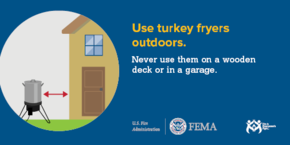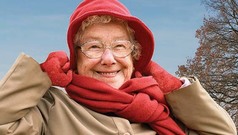
|
 Deep
frying a turkey may be delicious but it can also be dangerous.
According
to the U.S. Fire Administration (USFA), Thanksgiving is the peak day for home cooking fires
and frying food increases the risk. Keep your family safe by following these
five safety tips:
- Use your turkey
fryer only outdoors on a sturdy, level surface away from things that can burn. Make
sure to have a “3-foot kid- and pet-free zone” around your turkey fryer to protect
against burn injuries. Turkey fryers can easily tip over spilling hot oil across
a large area.
- Determine the
correct amount of oil needed by first placing the turkey in the pot with water.
An overfilled cooking pot will cause oil to spill over when the turkey is
placed inside.
- Make sure your
turkey is completely thawed before you fry it. A partially frozen turkey will
cause hot oil to splatter.
- Check the
temperature often with a cooking thermometer so the oil will not overheat.
Turkey fryers can easily overheat and start a fire.
- Use long cooking
gloves that protect hands and arms when you handle these items. The pot, lid
and handles of a turkey fryer can get dangerously hot and cause burn injuries.
For more tips, visit the USFA’s Cooking Fire Safety page.
|
 Not only should kids wear a
coat to avoid catching a cold, but older adults should, too.
The National Institute on Aging (NIA) says older adults lose body
heat faster than when they were young. Review the cold weather safety tips from NIA
and share the following tips on how to stay warm:
- Set your heat at 68°F or
higher. To save on heating bills, close off rooms you are not using. Close the vents
and shut the doors in these rooms, and keep the basement door closed. Place a
rolled towel in front of all doors to keep out drafts.
- Make sure your house is not
losing heat through windows. Keep your blinds and curtains closed. If you have
gaps around the windows, try using weather stripping or caulk to keep the cold
air out.
- Dress warmly on cold days
even if you are staying in the house. Throw a blanket over your legs. Wear
socks and slippers.
- When you go to sleep, wear
long underwear under your pajamas, and use extra covers. Wear a cap or hat.
- Make sure you eat enough
food to keep up your weight. If you do not eat well, you might have less fat
under your skin. Body fat helps you to stay warm.
- Drink alcohol moderately, if at
all. Alcoholic drinks can make you lose body heat.
- Ask family or friends to
check on you during cold weather. If a power outage leaves you without heat,
try to stay with a relative or friend.
For more tips, check
out Cold Weather Safety for Older Adults from NIA.
|
Community Emergency Response Teams (CERT) and Citizen
Corps Councils are getting a new and improved registration and management
website, which will allow users a more intuitive and robust tool with which to
manage their programs. While these enhancements occur, the current website will
be down starting December 1st .
The new and improved site will still include features like:
- Registering and updating Citizen Corps and CERT
programs from one place;
- Collecting information about surveys and
programs to enable better tracking of your work; and
- Searching for local preparedness programs.
The site will also include some new features to make preparing
your community even easier.
You can look forward to accessing the site later in December. In
the meantime, you can continue helping your community get ready for disaster by
visiting the Citizen Corps and CERT program pages on Ready.gov.
On
Tuesday, November 28, the Federal Emergency Management Agency’s Individual and Community Preparedness
Division and Child Care Aware of America invite you to participate in a webinar
featuring best practices on addressing adjustment difficulties of children in
the aftermath of a disaster and discussing successful coping strategies.
Title: Supporting Children in the Aftermath of Disasters
Date: Tuesday, November 28, 2017
Time: 2:00 – 3:00 p.m. ET
How to Join the
Webinar:
We hope that you will be able to join us on November 28!
In observance of National Native American Heritage Month, the Federal Emergency Management Agency’s
Individual and Community Preparedness Division and the Office of External
Affairs Tribal Affairs will host a webinar on Wednesday, November 29 from
3:00 to 4:00 p.m. ET focusing on disaster preparedness and resilience
efforts serving tribal communities. You’ll hear from several leaders who have
worked to put preparedness into action.
Title: Commemorating Native American Heritage Month through
Tribal Emergency Management
Date: Wednesday, November 29, 2017
Time: 3:00 – 4:00 p.m. ET
How to Join the
Webinar:
We hope that you will be able to join us on November 29!
Disclaimer: The reader recognizes
that the federal government provides links and informational data on various
disaster preparedness resources and events and does not endorse any non-federal
events, entities, organizations, services, or products. Please let us know
about other events and services for individual and community preparedness that
could be included in future newsletters by contacting citizencorps@fema.dhs.gov.
|

|